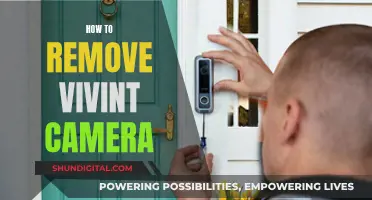
The rise of surveillance systems and their increasing online functionality have made it possible for anyone with an internet connection to access thousands of cameras online. In fact, you don't need to be a hacker to view unsecured cameras as there are several websites that provide access to hacked security cameras that are live-streaming from people's homes, businesses, and public spaces. This is a huge privacy issue, and it is important to take steps to secure your own cameras and protect your privacy.
| Characteristics | Values |
|---|---|
| Ease of access | Unsecured cameras are easily accessible to anyone with an internet connection. Websites such as Insecam.org, Opentopia, and Controllable Webcams list thousands of unsecured cameras from around the world. |
| No hacking skills required | Anyone can access unsecured cameras without needing advanced technical or hacking skills. Simple Google searches or scanning QR codes can lead to unsecured cameras. |
| Types of cameras | Unsecured cameras can include IP security cameras, DVRs (Digital Video Recorders), CCTV cameras, and traffic/surveillance cameras. |
| Risks | Unsecured cameras pose significant privacy risks as they can provide live feeds from people's homes, bedrooms, bathrooms, and other private spaces. |
| Prevention | To prevent unauthorized access, it is crucial to change default usernames and passwords, purchase cameras from reputable brands, avoid installing cameras in private spaces, and regularly update camera firmware. |
What You'll Learn

Using websites like Insecam, Opentopia, Camhacker, Shodan, Thingful, Zoomeye, and more
There are a number of websites that allow users to view unsecured cameras. Insecam is one of the largest directories of unsecured cameras, with around 73,000 unsecured cameras available to view. The website provides information such as the camera manufacturer, default login and password, time zone, city, and a pinpointed location on Google Maps. Insecam claims to have taken steps to protect individual privacy, such as only including filtered cameras and removing any private or unethical camera upon request.
Another website with similar functionality is Opentopia, which also lists thousands of unsecured cameras and allows users to leave comments. Opentopia also allows users to select the type of stream they want to receive, such as refreshing still pictures or live feeds.
Other websites that provide access to unsecured cameras include Camhacker, Shodan, Thingful, and Zoomeye. These websites allow users to view unsecured cameras from around the world, often without the knowledge or consent of the camera owners. It is important to note that accessing unsecured cameras without authorization may be illegal in some jurisdictions and may violate the privacy of individuals being recorded.
Becoming a TV Camera Person: Skills and Steps
You may want to see also

Exploiting well-known vulnerabilities
One of the most common ways to do this is by using default login credentials. Many people fail to change the default username and password when they install a new camera, which means that, with a little research, anyone can find the default login credentials for a particular camera model online. This is especially true for cameras that use P2P (peer-to-peer) features, which allow users to connect to their devices as soon as they come online. Flaws in these features can be exploited to find vulnerable cameras and launch attacks to access them.
Another way to exploit vulnerabilities is through the use of advanced search tags on Google. By pairing advanced search tags such as "intitle," "inurl," and "intext" with names of commonly-used cameras or fragments of URLs, one can find direct links to live video feeds from thousands of IP cameras. This method was popularised on forums such as 4chan and SomethingAwful, with members posting pages of Google-ready search strings that grant access to dozens of different camera makes and models.
In addition, many cameras use outdated or vulnerable firmware. Hackers can remotely use security holes in outdated firmware to gain access to camera systems, even without knowing the password. This is another example of a well-known vulnerability that can be exploited to access unsecured cameras.
OLED LG Smart TV: Built-in Camera?
You may want to see also

Using Google search strings to find unsecured IP cameras
Google search strings can be used to find unsecured IP cameras, which can then be accessed by anyone with an internet connection. This is possible because IP cameras are often not secured correctly or at all, and can be accessed without hacking.
Google has indexed thousands of unsecured IP cameras, and with a few keywords and some simple syntax, anyone can access them. The search engine provides IP addresses, camera names, and model numbers, and by using advanced search tags such as "intitle," "inurl," and "intext" along with commonly used camera names or URL fragments, one can find direct links to live video feeds.
For example, a standard Google search for "Axis 206M" (a 1.3-megapixel IP camera) will yield pages of spec sheets and sites where the camera can be purchased. However, changing the search to "intitle: 'Live View / - AXIS 206M'" will return links to cameras that are online and viewable. This is because the modified search specifically looks for the name of the camera's remote viewing page.
Some cameras are even easier to find. For instance, a search for "Mobotix M10," the make and model of the camera, will return similar results to the more complex search string "intext:'MOBOTIX M10' intext:'Open Menu'," which will bring up direct links to cameras that are online and ready to be viewed.
Entire online communities have sprung up around finding and watching unsecured cameras, with forums like 4chan and SomethingAwful having large threads dedicated to the topic. Members of these groups have posted pages of Google-ready search strings, making it easy for anyone to access unsecured cameras with just a little effort and no technical knowledge.
It is important to note that while these methods can access unsecured webcams, they will not work for secured cameras.
Viewing Wyze Cameras on PC: A Simple Guide
You may want to see also

Using software that scans the internet for security camera links
There are several software options that can be used to scan the internet for security camera links. These software tools work by constantly scanning the internet for unprotected devices, and they can provide a list of unsecured camera feeds that can be accessed online.
One example of such software is the website insecam.org, which has a list of thousands of unsecured cameras from all over the world, with a high number of cameras in the United States, Japan, Italy, France, the UK, Russia, and Spain. The website allows users to browse through live feeds from people's homes, with the owners often being unaware that they are being watched. Insecam.org finds these unsecured cameras by randomly trying default usernames and passwords, and if they gain access, they add the camera to their live online list.
Another similar website is Opentopia, which also lists thousands of unsecured cameras and allows users to leave comments. Opentopia offers additional features such as selecting the type of stream (still pictures, animations, or live feed) and creating an account to comment on the cameras.
Other software tools that can be used to find unsecured cameras include IoT/device search engines such as Shodan, Thingful, Zoomeye, and Camhacker. These search engines allow users to find and access unsecured cameras by using specific search queries or "Google dorks."
It is important to note that accessing unsecured cameras without authorization is an invasion of privacy and may be illegal in some jurisdictions. The information provided here is for educational purposes only, and users should respect the privacy of others and not engage in unauthorized access or surveillance.
Transform Your Camera into a TV: A Step-by-Step Guide
You may want to see also

Using default login credentials
Websites such as insecam.org and Opentopia take advantage of this by randomly trying default usernames and passwords to find unsecured cameras, which they then list on their websites for anyone to access. Insecam.org, for example, has a list of thousands of unsecured cameras from all over the world, and most of the owners have no idea that they are being watched.
To protect yourself from this type of invasion of privacy, it is important to change the default username and password on your security camera. Default login credentials are usually a combination of "admin" as the username and "admin" or "12345" as the password. These combinations are easy to guess and are also available online or in the camera's manual. Therefore, it is crucial to change them as soon as you install the camera.
In addition to changing the default login credentials, there are other measures you can take to increase the security of your security cameras. This includes purchasing cameras from reputable brands that offer continuous technical support and regular firmware updates, avoiding installing cameras in private spaces, and keeping your cameras updated with the latest firmware releases.
Access Yi Home Camera Footage on Windows 10
You may want to see also
Frequently asked questions
There are several websites that allow users to watch unsecured cameras, such as Insecam.org, Opentopia, Camhacker.com, Shodan.io, Thingful.net, Zoomeye.org, and Hackmyass.wordpress.com. These websites provide access to unsecured security cameras in people's homes, businesses, and public spaces. However, it is important to note that accessing these cameras without authorization is an invasion of privacy and may be illegal.
Unsecured cameras pose significant risks to privacy and security. They can be easily accessed by unauthorized individuals, allowing them to invade people's privacy and even spy on their homes or businesses. Additionally, unsecured cameras can be hacked and used for malicious purposes, such as burglary or stalking.
To protect your camera from unauthorized access, it is crucial to change the default username and password. Manufacturers often set default passwords that are easy to guess or find online. By creating a strong and unique password, you can significantly improve the security of your camera. Additionally, consider purchasing cameras from reputable brands that prioritize security and provide regular firmware updates.
If you are concerned about the security risks associated with unsecured cameras, there are alternative options for home security. You can install cameras that are not connected to the internet, ensuring they cannot be accessed remotely. Additionally, consider implementing a multi-level security system that utilizes motion sensors, alarm systems, and physical barriers alongside or instead of cameras.







